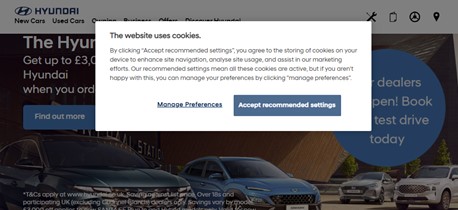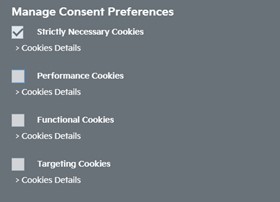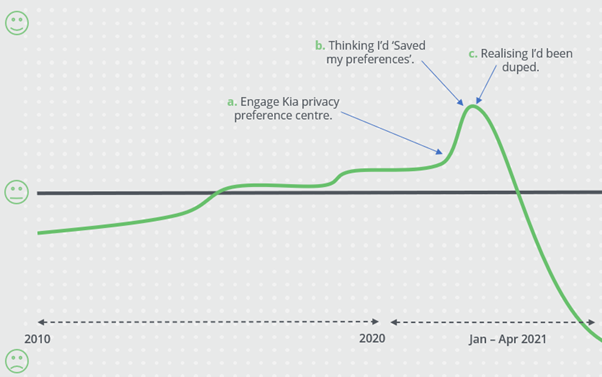Cookies, GDPR and spreadsheets: Three conversation-stoppers. Pause for a moment’s consideration and I see a common theme: Respect, or the lack of it. Corporates are asking their customers to literally tick the box, to figuratively tick another box.
The use of Cookies on websites has been hot news since GDPR launched in 2018. Power to the people? Well, to be honest, everyone I speak with admit to mostly just accepting and moving forward. Which is no different than before.
So, what does this mean to you, your website, and your customers? Does it really matter?
The ‘easiest’ Cookie notice, from the point of view of your brand, is to just offer users an obvious ‘Accept All’ button. Most users are likely to Accept, and you can then track them and use the data for website improvement and marketing purposes.
 Classic cookies accept window – Hyundai
Classic cookies accept window – Hyundai
But is this the right way? If we were sitting in a pub garden chatting as friends, you will no doubt agree with me that end-users deserve to be given more control and encouraged to make changes. However, if we switch to being sat in a business meeting, all focus is now on harvesting as much data as possible, and how important it is to track user behaviour.
GDPR’s purpose is to protect consumers through consent, and choice. Yet we find ourselves in a place where most companies force-feed us Cookies, and consumers thoughtlessly accept. What is the point?
Is there an ethical or moral responsibility to awaken cookie-conscious consumers? How do you feel about that?
What are the options?
User-centric – Well, you can focus on providing choice, and have all Cookies switched off as a default. Place control in the hands of the user. Of course, you may end up tracking no data.
Safe – The binary choice gives equal prominence to ‘accept all’ and ‘reject all’. Clear and straight forward, however uncomfortable this may make your marketing team.
Proactive – You could list options with some data capture defaulted ‘On’. This provides the user some control, whilst making sure you also capture data, unless the users decide to switch it off.
Sleight of hand – Or you can fool users into thinking they have control, but then making sure they ‘Accept All Cookies’ anyway. This method was recently introduced to me via Kia.
Electrifying Cookies
Innocently scrolling through Instagram, I came upon an elegant looking electric car. The KIA EV6. I am not in the market for a new car, but I like to have a look, so I happily tapped the button to find out more.
I was presented with a beautifully crafted Privacy Preference Centre. In all honesty, I was impressed. There was a bit of blurb, which I duly ignored, followed by a ‘Manage Consent Preferences’ list. This was very nice.
 Manage Consent Preferences – Kia
Manage Consent Preferences – Kia
‘Strictly Necessary Cookies’ is defaulted to on (and can’t be turned off). I wonder if this ticked box nudged me to engage. Was that a masterstroke of design?
Well, my sentiment towards Kia had gone up so I even made a conscious decision to tick ‘Performance Cookies’. Ready to go, I tapped the button to have a look at the car…. but wait.
It was at that moment, just as I clicked the button, that I realised I had been tricked. The big obvious CLICK ME button said, ‘Allow All’. The small, barely visible button said Save Settings. I felt duped.

Having been impressed by Kia, and taking some time to consider my preferences, I was then tricked into accepting all Cookies anyway. At the point of realisation, my sentiment towards Kia dropped through the floor.
If the buttons had been switched in the design, the story I would tell would be glowing (I was about to message the Experience UX team on what a good Cookie experience this was), and my personal sentiment towards Kia had jumped.
However, the story I now tell anyone who will listen is one of anger.
 My Kia sentiment journey
My Kia sentiment journey
Let me choose my cookies
A 2020 study suggests that many cookie consent pop-ups are in flagrant disregard of privacy laws, despite two years of GDPR. Only 11.8% of the UK’s top 10,000 websites met the minimal requirements of GDPR law.
Co-author of the study, Dr Michael Veale, of UCL said:
I want to see a web where users don’t need to distrust sites in the way they need to now, for personal privacy and computer security.
I would like to see that future, a world where consumers feel cared for by brands. But I know that we live in the real world. And the reality is that the board room is not close enough to its customers. It lacks respect for its users. It is not a conscious disrespect; they are just not close enough to feel their customers’ experience. Their eyes are on the spreadsheets.
I am not anti-data, data is critical. But are you using it with a human perspective in your heart? If you are a business offering products and services, you have a responsibility to think about customers and people.
You can see from my sentiment journey with Kia, that small things can have a big impact. If you are in a brand that is here for the long term, that wants to make a difference, that wants to do business right, there is an opportunity in delivering user-centric products and services.
Too many businesses are thinking short term, and in the current crisis that is understandable, but often this neglects common decency. To win the short term gain, companies find themselves manipulating users. Manipulation is the use of clever design tactics (see Kia above) to make you behave in a way you would not have naturally, were you making a conscious choice. If you cannot keep your business going without manipulating people, should you be in business?
What does success look like?
Can we sow more organic, authentic, and honest relationships with our website visitors in a way that does not require Cookies?
Default your cookies to off. Then build a respectable relationship with users so they make a conscious decision to allow you to track them. This will reap longer-term relationships and build stronger brand sentiment.
Good customer sentiment might also trigger users to invest short term with you too, even if that is letting you track them. That should be seen as a success and a sign that you, your website, and your brand are doing something right.
Measure success in terms of relationship, sentiment and loyalty as opposed to traffic and clicks. Wouldn’t that make a nicer internet?
Do not be a Cookie Monster. Invite your people to consume cookies consciously for a better user experience, and better business practice.

